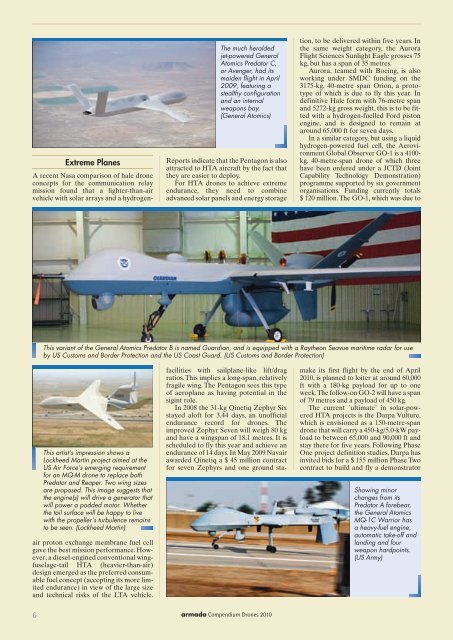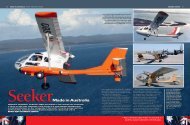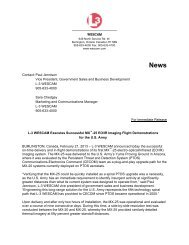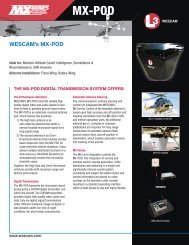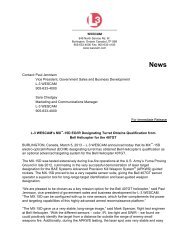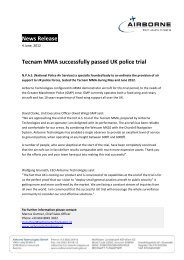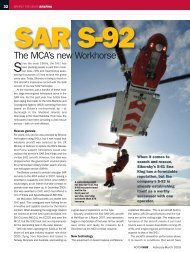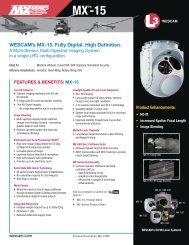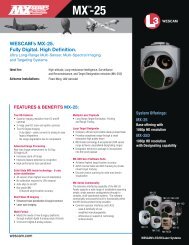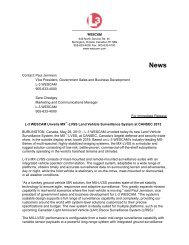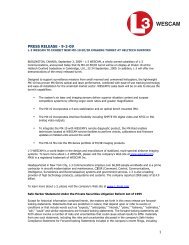Sensors - Wescam
Sensors - Wescam
Sensors - Wescam
Create successful ePaper yourself
Turn your PDF publications into a flip-book with our unique Google optimized e-Paper software.
Extreme Planes<br />
A recent Nasa comparison of hale drone<br />
concepts for the communication relay<br />
mission found that a lighter-than-air<br />
vehicle with solar arrays and a hydrogen-<br />
The much heralded<br />
jet-powered General<br />
Atomics Predator C,<br />
or Avenger, had its<br />
maiden flight in April<br />
2009, featuring a<br />
stealthy configuration<br />
and an internal<br />
weapons bay.<br />
(General Atomics)<br />
Reports indicate that the Pentagon is also<br />
attracted to HTA aircraft by the fact that<br />
they are easier to deploy.<br />
For HTA drones to achieve extreme<br />
endurance, they need to combine<br />
advanced solar panels and energy storage<br />
tion, to be delivered within five years. In<br />
the same weight category, the Aurora<br />
Flight Sciences Sunlight Eagle grosses 75<br />
kg, but has a span of 35 metres.<br />
Aurora, teamed with Boeing, is also<br />
working under SMDC funding on the<br />
3175-kg, 40-metre span Orion, a prototype<br />
of which is due to fly this year. In<br />
definitive Hale form with 76-metre span<br />
and 5272-kg gross weight, this is to be fitted<br />
with a hydrogen-fuelled Ford piston<br />
engine, and is designed to remain at<br />
around 65,000 ft for seven days.<br />
In a similar category, but using a liquid<br />
hydrogen-powered fuel cell, the Aerovironment<br />
Global Observer GO-1 is a 4100-<br />
kg, 40-metre-span drone of which three<br />
have been ordered under a JCTD (Joint<br />
Capability Technology Demonstration)<br />
programme supported by six government<br />
organisations. Funding currently totals<br />
$ 120 million. The GO-1, which was due to<br />
This variant of the General Atomics Predator B is named Guardian, and is equipped with a Raytheon Seavue maritime radar for use<br />
by US Customs and Border Protection and the US Coast Guard. (US Customs and Border Protection)<br />
This artist’s impression shows a<br />
Lockheed Martin project aimed at the<br />
US Air Force’s emerging requirement<br />
for an MQ-M drone to replace both<br />
Predator and Reaper. Two wing sizes<br />
are proposed. This image suggests that<br />
the engine(s) will drive a generator that<br />
will power a podded motor. Whether<br />
the tail surface will be happy to live<br />
with the propeller’s turbulence remains<br />
to be seen. (Lockheed Martin)<br />
air proton exchange membrane fuel cell<br />
gave the best mission performance. However,<br />
a diesel-engined conventional wingfuselage-tail<br />
HTA (heavier-than-air)<br />
design emerged as the preferred consumable<br />
fuel concept (accepting its more limited<br />
endurance) in view of the large size<br />
and technical risks of the LTA vehicle.<br />
facilities with sailplane-like lift/drag<br />
ratios. This implies a long-span, relatively<br />
fragile wing. The Pentagon sees this type<br />
of aeroplane as having potential in the<br />
sigint role.<br />
In 2008 the 31-kg Qinetiq Zephyr Six<br />
stayed aloft for 3.44 days, an unofficial<br />
endurance record for drones. The<br />
improved Zephyr Seven will weigh 80 kg<br />
and have a wingspan of 18.1 metres. It is<br />
scheduled to fly this year and achieve an<br />
endurance of 14 days. In May 2009 Navair<br />
awarded Qinetiq a $ 45 million contract<br />
for seven Zephyrs and one ground stamake<br />
its first flight by the end of April<br />
2010, is planned to loiter at around 60,000<br />
ft with a 180-kg payload for up to one<br />
week. The follow-on GO-2 will have a span<br />
of 79 metres and a payload of 450 kg.<br />
The current ’ultimate’ in solar-powered<br />
HTA projects is the Darpa Vulture,<br />
which is envisioned as a 150-metre-span<br />
drone that will carry a 450-kg/5.0-kW payload<br />
to between 65,000 and 90,000 ft and<br />
stay there for five years. Following Phase<br />
One project definition studies, Darpa has<br />
invited bids for a $ 155 million Phase Two<br />
contract to build and fly a demonstrator<br />
Showing minor<br />
changes from its<br />
Predator A forebear,<br />
the General Atomics<br />
MQ-1C Warrior has<br />
a heavy-fuel engine,<br />
automatic take-off and<br />
landing and four<br />
weapon hardpoints.<br />
(US Army)<br />
6 armada Compendium Drones 2010


